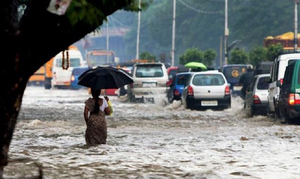Rising temperatures and social unrest

Quite often climate change and catastrophes relating to health, disasters are linked with it.
By Tikender Panwar
Quite often disasters are linked with climate change and catastrophes relating to health. However, there is another domain that needs to be thoroughly looked into and that is the impact of climate change on social unrest.
In his novel, the ‘Drowned World’, JG Ballard conjured up melting ice caps, English capital submerged under the tropical marshes and population fleeing the unbearable heat toward polar redoubts 1. Well, this may sound fallacious but not unimaginable in the context. The US intelligence has in its 2013 worldwide threat assessment put climate change as a major trigger for people’s unrest 2.
Accordingly, extreme weather events will put food markets under serious strain triggering riots, civil disobedience, and vandalism. “If the armed forces are firefighters tasked with suppressing outbreaks of rebellion their workload will increase in a warming world”.
Another interesting work by Soloman Hsiang titled, ‘Rising temperatures’ translate into social turbulence works with a meta data of 10000 years of world history with 50 data sets and explicitly propounds that on all scales, in all cultures, anomalously hot weather induces hostile honking, police brutality, baseball pitchers hitting batters, urban riots and at the end social turbulence 3. It proceeds to conclude that if the past is anything to go by, a hotter 21st century will see all manner of strife – the future holds nothing else but confrontation. This confrontation zone can be witnessed in different parts of the globe. Syria is a classic example where epochal drought, 2006-10, in the Mediterranean basin paved way for the conflict to rise. Not only the winter rains failed, but the higher temperatures sped up evaporation in summertime, depleting groundwater and streams and parching the soil. There was no natural explanation for the trend. It can only be ascribed to the emissions of greenhouse gases.
We all know the situation in the region now where it has become a major conflict zone. Estimates range between two million displaces farmers and herders. Fleeing wastelands, hunkered down on the outskirts of Damascus, Aleppo and other cities joining the ranks of construction workers, taxi driving and so on. This got compounded with spiking food prices and extreme water shortage with taps flowing only once a week. Eventually, it led to a civil war in 2012.
Similar situation of climate change and the ‘threat multiplier’ effect is starkly witnessed in South Asia. In India, for example, in the state of Maharashtra continuous drought has led to people’s unrest and even large-scale peasant suicides. Of course, there is a general crisis in the peasanty which lays in the bottom of it but the drought acted as a catalyst. Similarly, the flooding of Chennai and Srinagar cities further alienated the citizens from the mainstream. The Gorakhpur city, in the largest state of Uttar Pradesh in India, shows another bizarre example of frequent deaths of children because of flooding of the region and spread of Encephalitis.
We might be living not right after, but at the very dawn of the age of extremes. And the dawdling contemporary system in place, as always, is guided by the rule: “Apres nous le deluge”. This must end. COP21 was a milestone but the backing out of a major contributor to the carbon footprint further escalates the crisis.
Policies that would save millions or even billions of lives could be put in place. There are ways of combating these catastrophes and damages are available and the measure required to combat them are clear and simple and within the reach of the people’s forces. But that has to be attained before it gets too late.
1. J.G. Ballard, The Drowned World, New York, 2012, p 58
2. ‘US Intelligence community worldwide threat assessment, statement for the record March 12, 2013’.
3. Solomon M Hsiang, quantifying the influence of climate change on Human conflict. 2013, p 341.
 Tikender Panwar is the former Deputy Mayor of Shimla.
Tikender Panwar is the former Deputy Mayor of Shimla.


